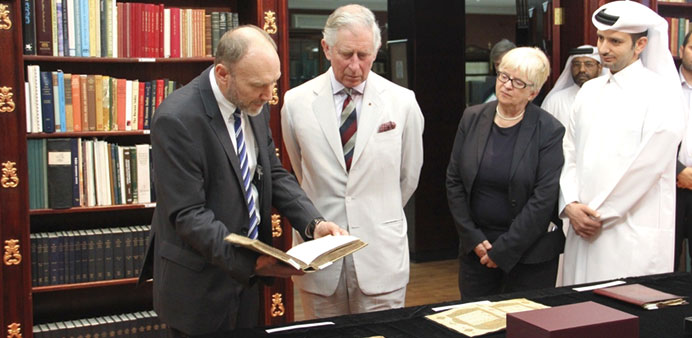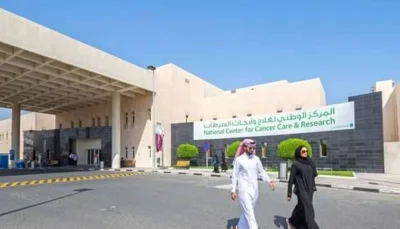Prince Charles with Dr Joachim Gierlichs, QNL’s associate director for Special Collections, Dr Claudia Lux and Saadi A al-Said, QNL’s associate director for Administration and Planning.
Qatar National Library (QNL) yesterday welcomed Prince Charles to its Arab and Islamic Heritage Collection during his latest official visit to Qatar.
With this, Prince Charles joins a growing number of high-profile guests and dignitaries from all over the world who have viewed the Heritage Collection.
QNL project director Dr Claudia Lux accompanied Prince Charles on his visit and highlighted some of the Heritage Collection’s most prized artefacts.
“We are honoured by the visit of Prince Charles to Qatar National Library’s Arab and Islamic Heritage Collection as it reinforces QNL’s vision of bridging cultures with knowledge,” she said. “This collection is one of the most important aspects of Qatar’s cultural landscape as it showcases the depth and richness of Arab-Islamic civilisation. We are, therefore, delighted to showcase this valuable trove of heritage and cultural items.”
Among the artefacts viewed by Prince Charles was the oldest map in the collection and one of the oldest in existence to mention Qatar. Dating back to 1478, it is based on the work of 2nd century CE astronomer, mathematician and geographer Claudius Ptolemaeus. A New Testament, printed in Aleppo, Syria, in 1706 and the first in the region to have been written in Arabic was also displayed.
Prince Charles was also shown an early script of the Holy Qur’an by Abraham Hinckelmann, published in Hamburg in 1694. Hinckelmann (1652-1695) was a German Protestant theologian and orientalist who first printed the Holy Qur’an by letterpress in the original Arabic.
HE Sheikh Hassan bin Mohamed bin Ali al-Thani founded the Heritage Collection in 1979 and it now provides an unparalleled contribution of historical sources about Qatar and the region. It includes writings by travellers and explorers who visited the Arabian Gulf region over the centuries, Arab manuscripts, historical maps and globes, as well as scientific instruments and early photography.
The Heritage Collection also features up to 2,400 precious manuscripts, among them Mushafs (Holy Qur’an) and Arabic literature, with a primary focus on sciences.



